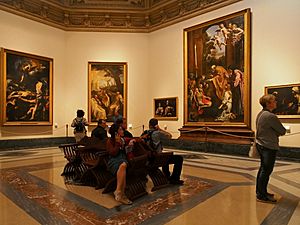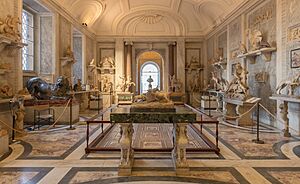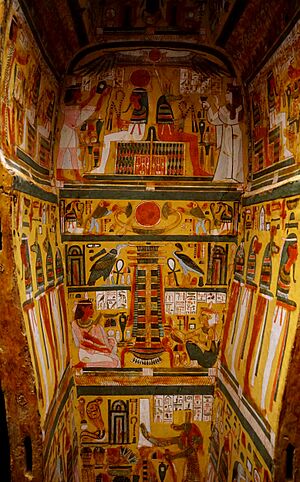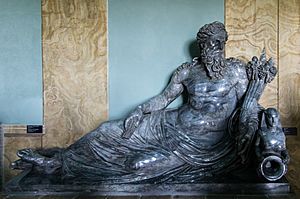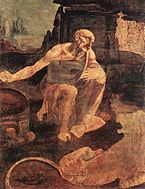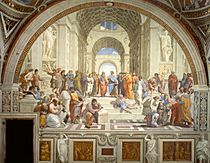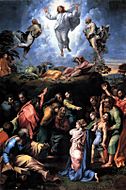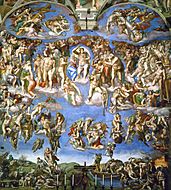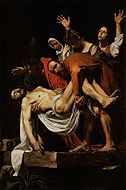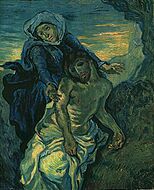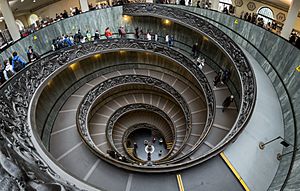Vatican Museums facts for kids
| Musei Vaticani | |
 |
|
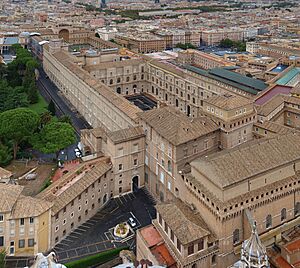
The Vatican Museums as seen from the dome of St. Peter's Basilica
|
|
| Established | 1506 |
|---|---|
| Location | Viale Vaticano 6, I-00192, Rome |
| Type | Art museum |
| Collection size | 70,000 |
| Visitors | 6,825,436 (2024) |
| Public transit access | |

The Vatican Museums (in Italian, Musei Vaticani) are a group of public museums located in Vatican City. They showcase an enormous collection of art and historical items. These treasures were gathered by the Catholic Church and the papacy over many centuries. You can find some of the most famous Roman sculptures and important Renaissance art masterpieces here.
The museums hold about 70,000 works of art. Around 20,000 of these are on display for visitors to see. Many people work here in different departments, from art restoration to managing the collections.
Pope Julius II started these museums in the early 1500s. Two very famous parts of the museums are the Sistine Chapel and the Raphael Rooms. The Sistine Chapel has its amazing ceiling and altar wall painted by Michelangelo. The Raphael Rooms were decorated by the artist Raphael. These works are considered some of the most important in Western art history.
In 2024, over 6.8 million people visited the Vatican Museums. This made them one of the most visited art museums in the world, second only to the Louvre in Paris. There are 24 galleries or rooms in total. The Sistine Chapel is usually the last room visitors see.
Contents
Exploring the Vatican Museums
The Vatican Museums began with a single marble sculpture. This sculpture, called Laocoön and His Sons, was found on January 14, 1506. It was discovered in a vineyard near a church in Rome. Pope Julius II sent famous artists Giuliano da Sangallo and Michelangelo to see it. They told the Pope it was amazing, so he bought it right away.
The sculpture shows the Trojan priest Laocoön and his two sons fighting giant snakes. The Pope put it on public display just one month after it was found. This event marked the beginning of the Vatican Museums.
Over the years, other popes added to the collections. For example, Pope Benedict XIV started the Museum Christianum. Later, Pope Pius IX created the Lateran Museum in 1854.
In October 2006, the museums celebrated their 500th anniversary. They opened up ancient burial sites on Vatican Hill for people to visit. Since January 1, 2017, Barbara Jatta has been the Director of the Vatican Museums.
Vatican Art Gallery: Pinacoteca Vaticana
The Pinacoteca Vaticana is the Vatican's art gallery, where many paintings are displayed. It used to be in the Borgia Apartment. But Pope Pius XI decided it needed its own building. A new building was designed and opened on October 27, 1932.
Here are some of the famous paintings you can find there:
- Giotto: Stefaneschi Triptych
- Filippo Lippi: Marsuppini Coronation
- Giovanni Bellini: Pietà
- Leonardo da Vinci: Saint Jerome in the Wilderness
- Raphael: Madonna of Foligno and Transfiguration
- Titian: Frari Madonna
- Caravaggio: The Entombment of Christ
- Nicolas Poussin: The Martyrdom of Saint Erasmus
Modern Religious Art Collection
The Collection of Modern Religious Art was added in 1973. It features paintings and sculptures by famous artists from more recent times. Some of these artists include Vincent van Gogh, Paul Gauguin, Marc Chagall, Salvador Dalí, and Pablo Picasso.
Sculpture Museums
The Vatican Museums also have several museums dedicated to sculptures. These are located around the Cortile del Belvedere (Belvedere Courtyard).
Pio-Clementino Museum
This museum is named after two popes: Pope Clement XIV and Pius VI. Pope Clement XIV started the museum in 1771. It originally held ancient and Renaissance artworks. Pope Pius VI later made the museum and its collection much larger. Today, it is home to many Greek and Roman sculptures.
Some interesting parts of this museum include:
- Octagonal Court: This courtyard was one of the first places where ancient statues from the papal collections were shown. Famous pieces like the Apollo of the Belvedere and Laocoön and His Sons have been here since the early 1500s.
- Sala Rotonda (Round Hall): This room looks like a smaller version of the Pantheon. It has ancient mosaics on the floor and statues around the edges. You can see a golden bronze statue of Hercules here.
- Greek Cross Gallery: This gallery holds the beautiful stone coffins (sarcophagi) of Constance and Saint Helena. They were the daughter and mother of Constantine the Great.
- Sala degli Animali (Hall of Animals): This room is named for its many ancient statues of animals.
Chiaramonti Museum
Pope Pius VII founded this museum in the early 1800s. His family name was Chiaramonti. The museum has a long, arched gallery filled with statues, sarcophagi, and decorative carvings.
The New Wing, called Braccio Nuovo, holds famous statues like the Augustus of Prima Porta. This wing has a wide, arched roof with skylights. Another part, the Galleria Lapidaria, has over 3,000 stone tablets with ancient writings. You usually need special permission to visit it for study.
Gregorian Etruscan Museum
Pope Gregory XVI started this museum in 1837. It has nine galleries filled with art and items from the Etruscan civilization. These pieces came from archaeological digs in areas once ruled by the Pope. The collection includes vases, sarcophagi, bronze items, and pottery.
Gregorian Egyptian Museum
This museum has a large collection of artifacts from Ancient Egypt. It also displays many Egyptian-style works made by Romans. You can see papyrus scrolls, sarcophagi, mummies, sculptures, and copies of the Book of the Dead here.
Vatican Historical Museum
The Vatican Historical Museum was created in 1973 by Pope Paul VI. It first opened in a garden area. In 1987, it moved to the main floor of the Lateran Palace, opening there in 1991. This museum tells the story of the Vatican's history.
Amazing Artworks to See
-
Raphael
The School of Athens
Raphael Rooms -
Depiction of Wandjina
Anima Mundi -
Vincent van Gogh – Pietà
Here are some other amazing things to see at the Vatican Museums:
- The red marble papal throne, which used to be in the Basilica of Saint John Lateran.
- Many Roman sculptures, ancient tombstones, and inscriptions. These include early Christian sarcophagi.
- The Raphael Rooms with incredible artworks by Raphael and his students. One famous painting is The School of Athens.
- The Niccoline Chapel, a small chapel with beautiful frescoes.
- The Sistine Chapel, famous for its stunning ceiling painted by Michelangelo.
- The Vatican Gallery of Maps: This gallery has huge maps of all of Italy painted on its walls. Friar Ignazio Danti created them in the late 1500s. It is the largest pictorial geographical study in the world.
- The frescoes and other artworks in the Borgia Apartment. This apartment was built for Pope Alexander VI.
- The Bramante Staircase is a unique double spiral staircase. Designed by Giuseppe Momo in 1932, it looks like two ramps winding around each other.
Visiting the Museums
The Vatican Museums are very popular. On the last Sunday of each month, they are open for free. Because of this, many people wait in line for hours to get in. On other days, you can buy tickets online or at the museum entrance.
Recent Events at the Museums
On August 18, 2022, two people from an activist group caused some damage to the marble base of the Laocoön statue. They were protesting about environmental issues. Experts said the statue suffered permanent damage. The repairs cost over 3,000 euros. A Vatican court later gave the three people involved suspended prison sentences and fines.
On October 5, 2022, a tourist damaged two ancient busts in the Chiaramonti Museum. One bust lost part of its nose and an ear. The other was knocked off its stand. Repairing these sculptures cost about 15,000 euros and took around 300 hours.
See also
 In Spanish: Museos Vaticanos para niños
In Spanish: Museos Vaticanos para niños
- Index of Vatican City–related articles
- List of largest art museums
- List of most visited art museums
- List of museums in Rome
- Michelangelo Simonetti


